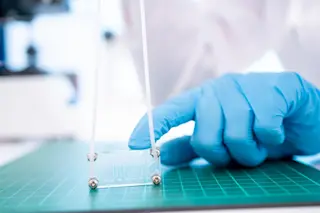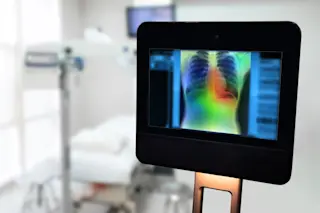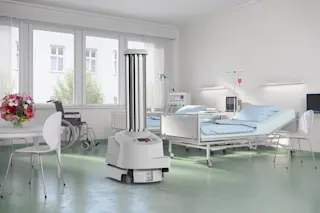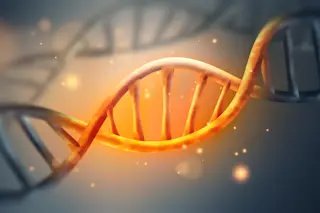In the late 1960s, medical researchers developed a way to find genetic defects in a fetus as young as 15 weeks, early enough to terminate a pregnancy with an abnormal fetus. Despite the need to have a long needle inserted into the uterus, many expectant mothers gratefully embraced amniocentesis, the now familiar genetic test. “It is truly a miracle,” a new mom told The New York Times in 1971. The woman’s three sisters had Down syndrome, and she had been terrified of passing on the disorder but got a null result. “I never thought I could have normal, healthy children.”
Another miracle is just around the corner: Researchers in Hong Kong and California are developing a technique that could read the entire contents of a fetal genome as early as 9 weeks into pregnancy, using very little blood from the mother. The test could reveal severe genetic disease, as well as a child’s eye color, and someday perhaps even height, intelligence, or athletic ability. It would be safe, affordable, and fast, but ethically challenging. “It’s very controversial,” says Arthur Beaudet, a pediatrician and genetic disease expert at Baylor College of Medicine. “Some families wouldn’t consider termination under any circumstances. But when faced with solid evidence of disabilities, many people give more thought to termination than they ever expected.”
Today genetic tests can screen for many conditions, including Down syndrome, Tay-Sachs disease, sickle-cell anemia, and cystic fibrosis. Expectant parents generally avoid the tests without prior reason for concern, however. Both amniocentesis and chorionic villus sampling (another invasive procedure that collects placental cells from within the womb) carry a 1 percent risk of miscarriage. For many women in the United States, the cost, discomfort, and health risks outweigh the benefits. Only about 200,000 women, or just 5 percent of all pregnancies, take advantage of these tests each year. “I saw these invasive procedures done to my wife and our unborn kids, and thought, there’s got to be a better way,” says Stephen Quake, a bioengineer at Stanford University.
Quake and Dennis Lo, a chemical pathologist at the Chinese University of Hong Kong, are helping craft the next generation of prenatal genetic tests. Last December they independently proved that a 10-milliliter blood sample—about two teaspoons—can reveal the entire fetal genome. With the cost of DNA sequencing at just $4,000 per complete genome and dropping fast, such tests could become routine, posing little risk to mom or baby.
A month later, Lo announced results from a study involving more than 750 women in which the blood test detected an extra copy of chromosome 21, indicative of Down syndrome, with nearly 100 percent accuracy. Down syndrome is the most common chromosomal disorder, affecting 1 in every 691 babies. Lo’s plans to launch a Down syndrome blood test for mothers in Hong Kong later this year is provoking strong reaction. “Advocates for Down syndrome are concerned that people would abort Down syndrome children. Antiabortion people are upset because this would presumably lead to more abortions,” says Hank Greely, a biomedical ethicist at Stanford University.
Lo sees the technology in a more beneficial light. He first hit upon the idea of a prenatal blood test for DNA in 1997 while reading about detecting cancer genes in blood plasma. “An unborn baby has some features that are quite similar to cancer,” he says. “I imagined the cancer growing in the patient as being similar to a baby growing in the mother. If a small tumor can release enough DNA into the plasma of a patient for us to detect it, maybe a seven-pound baby could do the same.”
At the time, scientists believed that fetal DNA existed only in cells within the womb. Lo realized they were wrong. Using a technology called polymerase chain reaction, or PCR, he was able to find minute snippets of fetal DNA floating freely in a pregnant woman’s blood and create millions of identical copies for analysis. The first application of this technique was in prenatal sex determination. Since females possess two X chromosomes and males have an X and a Y, if a mother’s blood sample showed DNA from a Y chromosome she was carrying a boy. No Y, and it was a girl.
Quick, simple sex determination could have major social implications. Although it is illegal in China and India to abort based on sex, such abortions happen more than a million times a year in those countries. A DNA test could provide sex information earlier in the pregnancy than an ultrasound can, but would require lab analysis. “Unlike someone with an ultrasound machine on a pushcart going from village to village, this test would be trickier to access,” Greely says. The broader question is how parents around the world will react to more detailed information about their unborn child’s attributes. Would they abort to have a taller son or one with blond hair? Should they be allowed to?
Lo and Quake remain focused on their original, much more clear-cut goal: early, safe diagnosis of debilitating disease. “There are many disorders we want to test for that don’t involve a question of aborting the fetus, just providing the baby with what it needs right when it’s born,” Quake says. “We plan to diagnose things like phenylketonuria, where the cure is as simple as avoiding certain foods. It would be a big improvement over figuring it out after birth in the hospital.” Lo and Quake hope to use their DNA blood tests to diagnose complicated genetic diseases like Tay-Sachs within the next two years. By 2017, they believe, some genetic prenatal blood tests will be ready for widespread use in the United States.
That’s not much time for prospective parents, genetic counselors, and legislators to consider how to handle the flood of fetal genetic information that science is about to unleash.
BuzzWords
AMNIOCENTESIS An invasive prenatal test that involves drawing fluid from the amniotic sac to test for birth defects.
DOWN SYNDROME A chromosomal disorder characterized by an extra copy of chromosome 21. The condition is usually associated with delayed mental and physical development.
CHORIONIC VILLUS SAMPLING A prenatal test that samples cells from the placenta. Both CVS and amniocentesis carry a slight risk of miscarriage.
FETAL DNA Genetic material from a developing baby. Once thought to be confined to cells in the womb, its sequence can now be reconstructed from segments circulating in the mother’s blood.
POLYMERASE CHAIN REACTION (PCR) A fast, inexpensive technique for making many copies of small DNA fragments.
PHENYLKETONURIA A genetic disorder that causes an inability to break down a molecule called phenylalanine, common in many foods.















